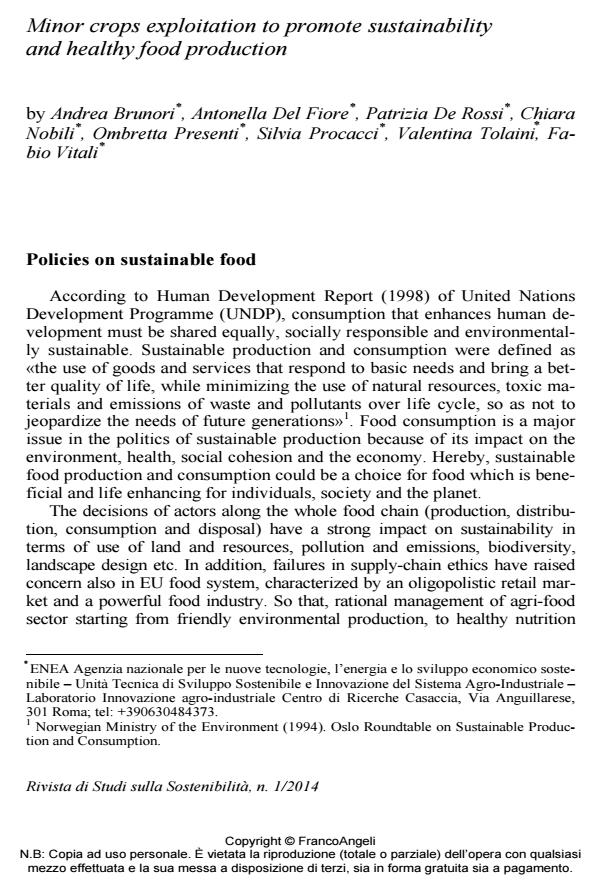Minor crops exploitation to promote sustainability and healthy food production
Journal title RIVISTA DI STUDI SULLA SOSTENIBILITA'
Author/s Andrea Brunori, Antonella Del Fiore, Patrizia De Rossi, Chiara Nobili, Ombretta Presenti, Silvia Procacci, Valentina Tolaini, Fabio Vitali
Publishing Year 2014 Issue 2014/1
Language Italian Pages 10 P. 35-44 File size 154 KB
DOI 10.3280/RISS2014-001004
DOI is like a bar code for intellectual property: to have more infomation
click here
Below, you can see the article first page
If you want to buy this article in PDF format, you can do it, following the instructions to buy download credits

FrancoAngeli is member of Publishers International Linking Association, Inc (PILA), a not-for-profit association which run the CrossRef service enabling links to and from online scholarly content.
Quantity and quality food production is a key component of well-being in its most modern and complete meaning. In this view, it has a significant impact on all aspects of social, cultural, environmental and economic development. For the future, the great challenge of agri-food sector is to carry out production systems that simultaneously adapt agriculture to territory, ensuring food supply, and significantly affect the health of consumers. The aim of this work is to reflect on the use of some minor crops, eco-friendly and rich in bioactive compounds, for sustainable production of ingredients for healthy foods.
La produzione di cibo in termini quantitativi e qualitativi rappresenta una componente fondamentale del benessere nella sua accezione più moderna e completa, in un approccio di sistema, incide significativamente su tutte le componenti sociali, culturali, ambientali ed economiche dello sviluppo. La grande sfida del settore agroalimentare per il futuro è trovare modelli di produzione che contestualmente adattino l’agricoltura al territorio, assicurino l’approvvigionamento alimentare e incidano significativamente sul benessere del consumatore. Con il presente lavoro si vuole dare spunto per una riflessione sull’uso di alcune colture minori, a basso impatto ambientale e ricche di composti bioattivi, per una produzione sostenibile di ingredienti per alimenti salutistici.
Keywords: Sustainability, sustainable agriculture, food chain, minor crops, healthy food, consumer
- Exploitation of Tartary Buckwheat as Sustainable Ingredient for Healthy Foods Production Valentina Tolaini, Antonella Del Fiore, Chiara Nobili, Ombretta Presenti, Patrizia De Rossi, Silvia Procacci, Fabio Vitali, Andrea Brunori, in Agriculture and Agricultural Science Procedia /2016 pp.455
DOI: 10.1016/j.aaspro.2016.02.043
Andrea Brunori, Antonella Del Fiore, Patrizia De Rossi, Chiara Nobili, Ombretta Presenti, Silvia Procacci, Valentina Tolaini, Fabio Vitali, Minor crops exploitation to promote sustainability and healthy food production in "RIVISTA DI STUDI SULLA SOSTENIBILITA'" 1/2014, pp 35-44, DOI: 10.3280/RISS2014-001004